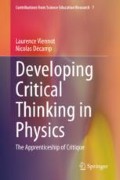Abstract
This chapter illustrates the main warning signals that could help us to detect the flaws of an explanation in physics: internal contradiction (two examples); direct contradiction of a law of physics (one example); indirect contradiction of a law of physics (one example); logical incompleteness of an explanation (three examples); overgeneralization (three examples); incompatibility with a thought experiment (three examples); incompatibility with an unperformed experiment (one example). Finally, we point out that several warning signals can intervene in parallel to question a given text, as shown in a last example (the direction of the current in the batteries).
Access this chapter
Tax calculation will be finalised at checkout
Purchases are for personal use only
References
Bächtold, M. (2012). Les fondements des sciences basés sur l’investigation. Tréma, 38, 7–39.
Belin. (2012). Sciences physiques Classe de Terminale S. Paris: Belin.
Brasquet, M. (1999). Actions, interactions et schématisation. Bulletin de l’Union des Physiciens, 816, 1220–1236.
Calmettes, B. (dir.). (2012). Didactique des sciences et démarches d’investigation. Paris: L’Harmattan.
Chabay, R. W., & Sherwood, B. A. (2006). Restructuring the introductory electricity and magnetism course. American Journal of Physics, 74, 329–336.
da Vinci. Del moto e misura dell’ acqua di da Vinci. A spese di Francesco Cardinali, Bologna (1828). Digitized copy of Harvard College Library, Google books. http://www.archive.org/stream/raccoltadautorii10card#page/n537/mode/1up
Das, S., Marchand, A., Andreotti, B., & Snoeijer, J. H. (2011). Elastic deformation due to tangential capillary forces. Physics of Fluids, 23, 072006.
Décamp, N., & Viennot, L. (2015). Co-development of conceptual understanding and critical attitude. Analysing texts on radio-carbon dating. International Journal of Science Education, 37(12), 2038–2063.
Edelson, D. C., Gordin, D. N., & Pea, R. D. (1999). Addressing the challenges of inquiry-based learning through technology and curriculum design. Journal of the Learning Sciences, 8(3–4), 391–450.
Ellenberg, J. (2015). How not to be wrong. London: Penguin.
EU. (2007). Science education now: A renewed pedagogy for the future of Europe (European Commission). Brussels: EC.
Flick, L. B., & Lederman, N. G. (Eds.). (2006). Scientific inquiry and nature of science: Implications for teaching, learning, and teacher education (Science & Technology Education Library). Dordrecht: Kluwer.
Gauvrit, N. (2007). Statistiques méfiez-vous! Paris: Ellipse.
Gormally, C., Brickman, P., Hallar, B., & Armstrong, N. (2009). Effects of inquiry-based learning on students’ science literacy skills and confidence. International Journal for the Scholarship of Teaching and Learning, 3(2), 16.
Hibon, M. (1996). La physique est un jeu d’enfant: activités d’éveil scientifique. Paris: A. Colin.
Jacquier, B., & Vannimenus, J. (2005). La lumière et la matière. Les Ulis: EDP Sciences.
Marchand, A., Weijs, J. H., Snoeijer, J. H., & Andreotti, B. (2011). Why is surface tension parallel to the interface. American Journal of Physics, 999–1008.
Menigaux, J. (1986). La schématisation des interactions en classe de troisième. Bulletin de l’Union des Physiciens, 683, 761–778.
Ogborn, J. (1996). Explaining science in the classroom (p. 65). Buckingham: Open University Press.
Santamaria, C. (2007). La physique tout simplement. Paris: Ellipses.
Viennot, L. (1982). L’action et la réaction sont-elles bien égales et opposées? Bulletin de l’Union des Physiciens, 640, 479–485.
Viennot, L. (2001). Reasoning in physics the part of common sense. Dordrecht: Springer.
Viennot, L. (2013). Les promesses de l’Enseignement Intégré de Science et Technologie (EIST): de la fausse monnaie? Spirale, 52, 51–68.
Viennot, L., & Décamp, L. (2016). Co-development of conceptual understanding and critical attitude: toward a systemic analysis of the survival blanket. European Journal of Physics, 015702 (26pp). https://doi.org/10.1088/0143-0807/37/1/015702
Author information
Authors and Affiliations
Rights and permissions
Copyright information
© 2020 Springer Nature Switzerland AG
About this chapter
Cite this chapter
Viennot, L., Décamp, N. (2020). Main Reasons to Call a Text into Question. In: Developing Critical Thinking in Physics. Contributions from Science Education Research, vol 7. Springer, Cham. https://doi.org/10.1007/978-3-030-43773-2_2
Download citation
DOI: https://doi.org/10.1007/978-3-030-43773-2_2
Published:
Publisher Name: Springer, Cham
Print ISBN: 978-3-030-43772-5
Online ISBN: 978-3-030-43773-2
eBook Packages: EducationEducation (R0)

